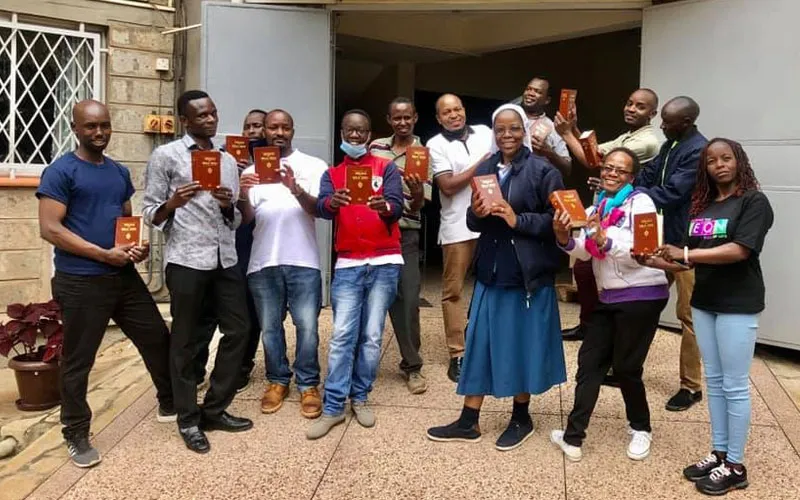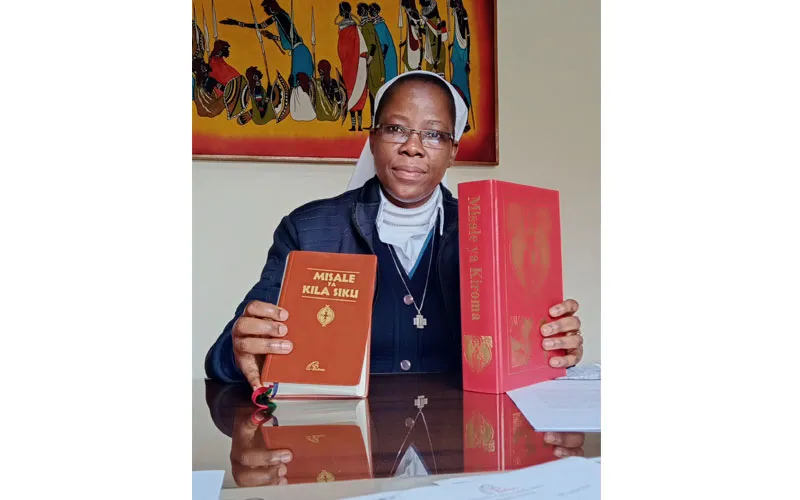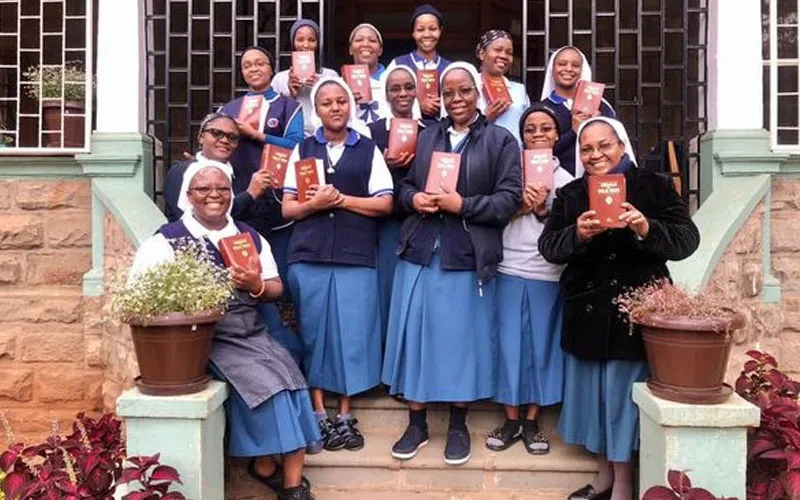She told ACI Africa that the two Commissions started working on the translation separately in 2014 and were later advised by the Vatican-based Congregation for Divine Worship and the Discipline of the Sacraments to synergize their efforts to come up with a more appropriate translation.
In 2014, the Liturgical Commission of KCCB visited their counterparts, the Liturgical Commission of TEC, which resulted in a collaborative approach to the translation exercise.
Having succeeded Bishop Kimengich at the Commission for Liturgy of KCCB in 2018, the Apostolic Vicar of Kenya’s Catholic Diocese of Isiolo, Bishop Anthony Ireri, led KCCB’s Liturgical team. The Local Ordinary of Tanzania’s Ifakara Diocese, Bishop Salutaris Melchior Libena, led the Liturgical team from TEC.
The challenge for the two Liturgical teams was settling on the most appropriate Kiswahili translations given the variations of this language in the two East African countries. This, Sr. Nafula says, is one of the reasons that the liturgical books took long to get published.
Additionally, the back-and-forth with the Bishop was consuming as both KCCB and TEC went through the documents and voted on the correct translations, the Kenyan-born Sister recalls.
(Story continues below)
“There was a lot of back-and-forth between the Liturgy Commissions and the Bishops’ Conferences. Sometimes, it took very long to agree on a single Swahili word. It required a lot of voting among the Bishops. A Swahili phrase had to get a majority vote to be approved in the translation,” she says.
It was only on 28 December 2020 that the Congregation for Divine Worship and the Discipline of the Sacraments allowed the Catholic Bishops to proceed with the publishing of the books.
Some of the changes in the Daily Missal include the response to “The Lord be with you”, which is now “Na awe rohoni mwako” (And with your spirit) and not the erroneous one, “Awe pia nawe”.
In “heaven and earth are full of your glory”, the word “earth” has been “dunia”. In the new Daily Missal, earth will be “ulimwengu”.
Responsorial psalm will be “zaburi ya kuitikizana” and not “wimbo wa katikati”.
Unlike the Misale ya Waumini that only had Sunday readings, Misale ya Kila Siku has readings from Monday tthrough Sunday, providing convenience, Sr. Nafula says.
“During COVID-19 lockdown and suspension of Masses, the challenge of accessing daily readings (was shared); we see people struggle to get daily readings because the Misale ya Waumini didn’t have daily readings. This is the gap that the Misale ya Kila Siku exists to fill since it has daily readings, from Monday to Sunday,” she says.
While working on the new translations, Catholic Bishops in Kenya and Tanzania also wrote to the Congregation for Divine Worship and the Discipline of the Sacraments requesting that African Saints be included in the translated versions.
In the Misale ya Kila Siku and Misale ya Kiroma, the people of God in Kenya and Tanzania will celebrate 19 Saints and the Blessed people of African origin.
“It is important for the Church in Africa to know their Saints apart from interacting with the universal ones. The new liturgical books provide for the celebration of these Saints. We also have a few Saints like Daniel Comboni who were not African but who had the spirit of Africa at the core of their various missions,” Sr. Nafula says.
In Misale ya Kiroma, various Latin phrases such as Kyrie, Gloria, and Sanctus have been inserted in their proper places. Additionally, abbreviations have been included for the sake of the concelebration of Holy Mass to guide the Priests especially during the Eucharistic celebration. Others include a proper calendar of African Saints as well as Gospel passages for Palm Sunday procession.
The Kiswahili Roman Missal also has illustrations prepared by African artists, the Directress of Paulines Publications Africa told ACI Africa, and added, “We even brought Kenyan musicians on board to work on the new musical notes that correspond with the translated phrases for Priests.”
The work of Paulines Publications Africa, the official of the Catholic publishing firm on the continent says, was to facilitate the work on the two liturgical books by taking care of the welfare of the two Liturgical Commissions that were involved in the translation of the books.
“Paulines Publications ensured that the meetings between the KCCB and TEC Liturgy Commissions were smooth and that the members of the Commissions had everything they required,” she said.
“Our editor, Fr. Ronzani Rinaldo, also followed up with the documents and oversaw their proofreading and typesetting. It was also our job to pay the editors of the books,” the Catholic Nun who worked on the project for three years up to its completion told ACI Africa August 18.
The prices of the two liturgical books have been set at KES.3,000 (US$30.00) for the Misale ya Kila Siku and KES.8,000 (US$80.00) for the Misale ya Kiroma.

The books, Sr. Nafula says, can be found in all Catholic bookshops in Kenya. In the Archdiocese of Nairobi, the books can be purchased at Holy Family Basilica, at the Daughters of St. Paul, Gabriella House in Karen, and at the Paulines Publications Africa in Westlands.
The Liturgical books will also be available in various Dioceses in Tanzania once printed, the official of Paulines Publications told ACI Africa.
 Sr. Praxides Nafula and a section of staff of Paulines-Books Centre in Nairobi posing for a photo holding newly published Misale ya Kilasiku.
Sr. Praxides Nafula and a section of staff of Paulines-Books Centre in Nairobi posing for a photo holding newly published Misale ya Kilasiku.
Another book, “Sala na Kanuni mpya ya Misa” going for KES.100 (US$1.00) has also been published alongside the other two Liturgical books to reach Christians who cannot afford the Daily Missal.
The book is also aimed at providing a simplified way to understand the new changes, which Sr. Nafula notes “may take a while to sink in.”
“It may take long for the faithful to adjust to changes because there is a specific way they have been observing the liturgy for many years. But with time, everyone will get there,” the Catholic Nun says, adding that the same goes for Priests.
She says that the new liturgical books will also be part of the curriculum for the training of Priests to help them adjust to the changes in Liturgical publications as early as possible.
The members of the Daughters of St. Paul are also going from Parish to Parish in Kenya to create awareness on the new Liturgical books.
“Our work on creating awareness on the two Swahili books started in June after we received a go ahead to publish the books. And we have never stopped. We dedicate the first Sunday of every month to going to Parishes not just to sell books but to also talk about them,” Sr. Nafula told ACI Africa August 18.
Agnes Aineah is a Kenyan journalist with a background in digital and newspaper reporting. She holds a Master of Arts in Digital Journalism from the Aga Khan University, Graduate School of Media and Communications and a Bachelor's Degree in Linguistics, Media and Communications from Kenya's Moi University. Agnes currently serves as a journalist for ACI Africa.




 Sr. Praxides Nafula, Directress of Paulines Publications Africa holds a copy of Misale ya Kila Siku (Daily Missal) during an interview with ACI Africa at her office in Westlands, Nairobi.
Sr. Praxides Nafula, Directress of Paulines Publications Africa holds a copy of Misale ya Kila Siku (Daily Missal) during an interview with ACI Africa at her office in Westlands, Nairobi.
 Members of the Daughters of St. Paul and a section of staff of Paulines-Books Centre in Nairobi posing for a photo holding newly published Misale ya Kilasiku.
Members of the Daughters of St. Paul and a section of staff of Paulines-Books Centre in Nairobi posing for a photo holding newly published Misale ya Kilasiku.
 Sr. Praxides Nafula and a section of staff of Paulines-Books Centre in Nairobi posing for a photo holding newly published Misale ya Kilasiku.
Sr. Praxides Nafula and a section of staff of Paulines-Books Centre in Nairobi posing for a photo holding newly published Misale ya Kilasiku.


